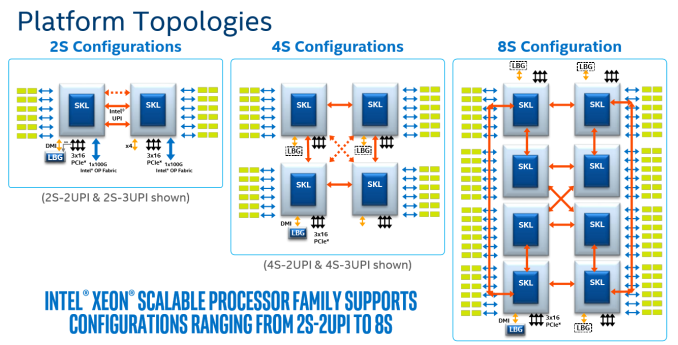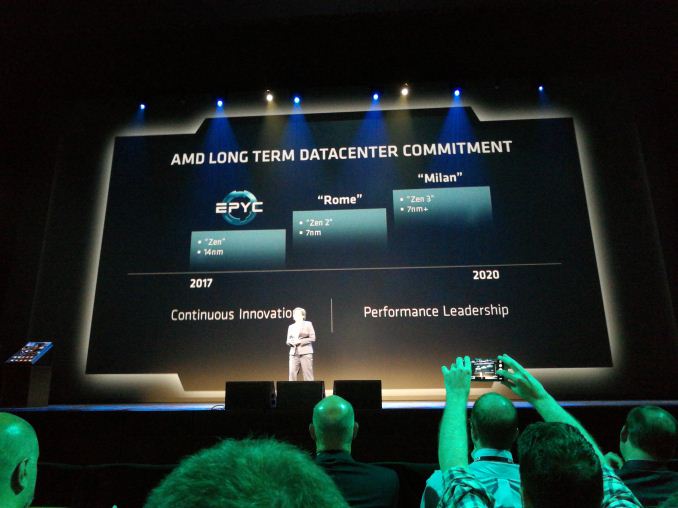Sizing Up Servers: Intel's Skylake-SP Xeon versus AMD's EPYC 7000 - The Server CPU Battle of the Decade?
by Johan De Gelas & Ian Cutress on July 11, 2017 12:15 PM EST- Posted in
- CPUs
- AMD
- Intel
- Xeon
- Enterprise
- Skylake
- Zen
- Naples
- Skylake-SP
- EPYC
Closing Thoughts
First of all, we have to emphasize that we were only able to spend about a week on the AMD server, and about two weeks on the Intel system. With the complexity of both server hardware and especially server software, that is very little time. There is still a lot to test and tune, but the general picture is clear.
We can continue to talk about Intel's excellent mesh topology and AMD strong new Zen architecture, but at the end of the day, the "how" will not matter to infrastructure professionals. Depending on your situation, performance, performance-per-watt, and/or performance-per-dollar are what matters.
The current Intel pricing draws the first line. If performance-per-dollar matters to you, AMD's EPYC pricing is very competitive for a wide range of software applications. With the exception of database software and vectorizable HPC code, AMD's EPYC 7601 ($4200) offers slightly less or slightly better performance than Intel's Xeon 8176 ($8000+). However the real competitor is probably the Xeon 8160, which has 4 (-14%) fewer cores and slightly lower turbo clocks (-100 or -200 MHz). We expect that this CPU will likely offer 15% lower performance, and yet it still costs about $500 more ($4700) than the best EPYC. Of course, everything will depend on the final server system price, but it looks like AMD's new EPYC will put some serious performance-per-dollar pressure on the Intel line.
The Intel chip is indeed able to scale up in 8 sockets systems, but frankly that market is shrinking fast, and dual socket buyers could not care less.
Meanwhile, although we have yet to test it, AMD's single socket offering looks even more attractive. We estimate that a single EPYC 7551P would indeed outperform many of the dual Silver Xeon solutions. Overall the single-socket EPYC gives you about 8 cores more at similar clockspeeds than the 2P Intel, and AMD doesn't require explicit cross socket communication - the server board gets simpler and thus cheaper. For price conscious server buyers, this is an excellent option.
However, if your software is expensive, everything changes. In that case, you care less about the heavy price tags of the Platinum Xeons. For those scenarios, Intel's Skylake-EP Xeons deliver the highest single threaded performance (courtesy of the 3.8 GHz turbo clock), high throughput without much (hardware) tuning, and server managers get the reassurance of Intel's reliable track record. And if you use expensive HPC software, you will probably get the benefits of Intel's beefy AVX 2.0 and/or AVX-512 implementations.
The second consideration is the type of buyer. It is clear that you have to tune more and work harder to get the best performance out of AMD EPYC CPUs. In many ways it is basically a "virtual octal socket" solution. For enterprises with a small infrastructure crew and server hardware on premise, spending time on hardware tuning is not an option most of the time. For the cloud vendors, the knowledge will be available and tuning for EPYC will be a one-time investment. Microsoft is already deploying AMD's EPYC in their Azure Cloud Datacenters.
Looking Towards the Future
Looking towards the future, Intel has the better topology to add more cores in future CPU generations. However AMD's newest core is a formidable opponent. Scalar floating point operations are clearly faster on the AMD core, and integer performance is – at the same clock – on par with Intel's best. The dual CCX layout and quad die setup leave quite a bit of performance on the table, so it will be interesting how much AMD has learned from this when they launch the 7 nm "Rome" successor. Their SKU line-up is still very limited.
All in all, it must be said that AMD executed very well and delivered a new server CPU that can offer competitive performance for a lower price point in some key markets. Server customers with non-scalar sparse matrix HPC and Big Data applications should especially take notice.
As for Intel, the company has delivered a very attractive and well scaling product. But some of the technological advances in Skylake-SP are overshadowed by the heavy price tags and somewhat "over the top" market segmentation.












219 Comments
View All Comments
alpha754293 - Tuesday, July 11, 2017 - link
Pity that OpenFOAM failed to run on Ubuntu 16.04.2 LTS. I would have been very interested in those results.farmergann - Tuesday, July 11, 2017 - link
Are you trying to hide the fact that AMD's performance per watt absolutely dominates intel's, or have you simply overlooked one of, if not the, single most important aspects of server processors?Ryan Smith - Tuesday, July 11, 2017 - link
Neither. We just had very little time to look at power consumption. It's also the metric we're the least confident in right now, as we'd like to have a better understanding of the quirks of the platform (which again takes more time).Carl Bicknell - Wednesday, July 12, 2017 - link
Ryan / Ian,Just to let you know there are better chess benchmarks than the one you've chosen. Stockfish is an example of a newer program which better uses modern CPU architecture.
NixZero - Tuesday, July 11, 2017 - link
"AMD's MCM approach is much cheaper to manufacture. Peak memory bandwidth and capacity is quite a bit higher with 4 dies and 2 memory channels per die. However, there is no central last level cache that can perform low latency data coordination between the L2-caches of the different cores (except inside one CCX). The eight 8 MB L3-caches acts like - relatively low latency - spill over caches for the 32 L2-caches on one chip. "isnt skylake-x's l3 a victim cache too? and divided at 1.3mb for each core, not a monolytic one?
Ian Cutress - Tuesday, July 11, 2017 - link
That's what a 'spill-over' cache is - it accepts evicted cache lines.NixZero - Wednesday, July 12, 2017 - link
so why its put as an advantage for intel cache, which is spill over too?JonathanWoodruff - Wednesday, July 12, 2017 - link
Since the Intel one is all on one die, a miss to a "slice" of cache can be filled without DRAM-like latencies from another slice. Since AMD has it's last level caches spread across dies, going to another cache looks to be equivalent latency-wise to going to DRAM. It wouldn't necessarily have to be quite that bad, and I would expect some improvement here for Zen2.Martin_Schou - Tuesday, July 11, 2017 - link
This has to be wrong:CPU Two EPYC 7601 (2.2 GHz, 32c, 8x8MB L3, 180W)
RAM 512 GB (12x32 GB) Samsung DDR4-2666 @2400
12 x 32 GB is 384 GB, and 12 sticks doesn't fit nicely into 8 channels. In all likelihood that's supposed to be 16x32 GB, as we see in the E52690
Dr.Neale - Tuesday, July 11, 2017 - link
I find myself puzzled by the curious omission in this article of a key aspect of Server architecture: Data Security.AMD has a LOT; Intel, not so much.
I would think this aspect of Server "Performance" would be a major consideration in choosing which company's Architecture to deploy in a Secure Server scenario. Especially in light of Recent Revelations fuelling Hacking Headlines in the news, and Dominating Discussions on various social media websites.
How much is Data Security worth?
A topic of EPYC consequence!